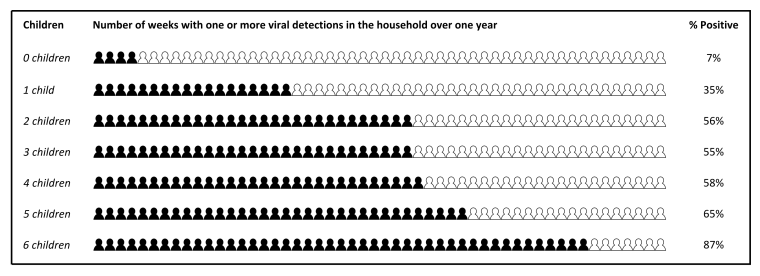The more kids you have, the more likely someone in your household is going to get sick, a new study finds.
It might not be completely surprising to any parent, but this probably is: Nearly half the time, the viruses didn’t cause any symptoms. Those most likely to have runny noses or other symptoms were the youngest children and babies, the team at the University of Utah School of Medicine found.
“As parents we love our children and we share everything with them and we share viruses with them as well,” said pediatrician Dr. Carrie Byiington, who helped lead the study.
Each child added to the viral burden, the researchers found in a yearlong survey of families in Utah.
“Compared with single person households, individuals living with children experienced three additional weeks of virus detection,” they wrote in the journal Clinical Infectious Diseases.
"Individuals living with children experienced three additional weeks of virus detection.”
It’s one of the most in-depth looks at just what germs circulate in families. The team signed up 26 households with 105 family members to start in 2009 and 2010. Three babies were born during the survey, bringing the final tally to 108.
“I thought Utah was the best place to do this study,” Byiington said. “We have big families. And we have families that also understand the importance of research.”
Each week, one of the adults swabbed everyone in the family, sent the sample to the lab, and reported on whether anyone had symptoms.
The lab checked for 16 common respiratory viruses — including rhinoviruses, coronaviruses, influenza, metapneumovirus and a fairly recently discovered virus family called bocaviruses. New tests are making it possible to identify such viruses — an area had been somewhat of a 'black hole' to medicine before advanced testing techniques were developed.
People without any kids were infected with viruses for three weeks to a month over the year. Adding one child brought that up to 18 weeks and families with six children had someone infected for up to 45 weeks of the year, the team, led by pediatric infectious disease expert Dr. Andrew Pavia, found.

Children under five were infected with some sort of virus half the time, they found. No one got seriously ill over the year of the study.
“Rhinovirus was the most commonly detected virus,” they wrote. “Overall, 100 out of 108 participants (93 percent) had rhinovirus detected in at least one weekly sample.”
But often, people were infected without symptoms. People reported symptoms just 56 percent of the time, the researchers found.
It’s important to know this because a sick child could be sent home if emergency room doctors stop looking once they find a usually mild virus such as a rhinovirus, the researchers said.
"If a child comes into the emergency room with severe respiratory illness and tests positive for rhinovirus, it might be a smart idea for doctors to make sure they're not missing something else that could be the cause," pediatrics professor Krow Ampofo, who worked on the study, said in a statement.
Bocaviruses were the second most common virus found, and they were the most persistent, hanging out in people’s noses as long as for three months, Byiington said.
The next step will be to look to see if there are differences among the kids who got symptoms from the viruses and those who did not.
“I frequently get asked by parents. ‘Is this normal or is there something wrong with this child? They always have a runny nose’,” Byiington said.
“I can now just point to the study and say, ‘Your child is normal’. A child under 5 has a virus in the nose for half the year.”
It makes sense – people build immunity as they get older and are exposed to more viruses. One thing they wanted to find out was whether some viruses are more likely to cause symptoms than others. More than half the time, doctors never know what made a person sick.
"A child under 5 has a virus in the nose for half the year.”
This study fingered coronaviruses – a large family of respiratory viruses that cause mostly unnamed infections, but that include the SARS and middle east respiratory syndrome (MERS) viruses.
“The majority (56 percent) of coronavirus episodes were symptomatic, suggesting that coronavirus infection may be an underrecognized cause of respiratory tract infection,” the researchers wrote.
“Studies like this one will help us understand the natural normal history of children with viruses,” Byiington added. “There may be some viruses that are good for us as well and we need to be exposed them at certain times in our lives.”
